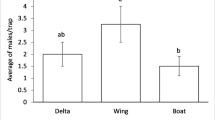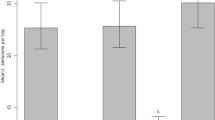Abstract
The effects of dispenser type, pheromone dose in the dispenser, aging of dispenser in the field, and trap type on trapping efficiency of males of the European vine moth,Lobesia botrana Den. et Schiff. (Lepidoptera: Tortricidae), were investigated. LB Pherocon caps and locally manufactured septa were equally effective in attracting males to traps. Within the range of 0.1 to 100 μg pheromone/dispenser, response of males increased positively with the pheromone dose. Within the first 7 days tested, pheromone loads of 1 or 10 mg/dispenser were significantly less attractive to males than 0.1 mg/dispenser. The effect of aging of the dispenser (loaded with 1 mg pheromone) in the field on trapping efficiency was significant. Captures in traps baited with 4- and 5-week-old septa were significantly lower (by 24%) than those in traps baited with 1-week-old septa. The fairly slow loss of attractancy exhibited by rubber septa indicates that septa may be kept in traps for at least 5 weeks. The release rate of the pheromone from the Israeli dispensers (1 mg loaded) was measured in a flow system. The emission of the pheromone decreased gradually as a function of age, correlating well with the lower trap catches of field-aged septa. Release rates were reduced by 56%, 70% and 84% after 4, 5 and 6 weeks, repectively. The nonsticky IPS trap was as effective in capturing the European vine moth males as the sticky Pherocon 1C trap. The possibility of using the non-sticky, nonsaturating and easy-to-handle IPS traps may lead to better and easier monitoring of the European vine moth populations.
Similar content being viewed by others
References
Anshelevich, L., Kehat, M., Dunkelblum, E. and Greenberg, S. (1993) Sex pheromone traps for monitoring the honeydew moth,Cryptoblabes gnidiella: Effect of pheromone compounds, pheromone dose, field aging of dispenser, and type of trap on male captures.Phytoparasitica 21: 189–198.
Avidov, Z. and Harpaz, I. (1969) Plant Pests of Israel. Israel Universities Press, Jerusalem.
Buser, H.R., Rausher, S. and Arn, H. (1974) Sex pheromone ofLobesia botrana: (E,Z)-7,9-dodecadienyl acetate in the female grape vine moth.Z. Naturforsch. Sect. C Biosci. 29: 781–783.
Daterman, G.E. (1982) Monitoring insects with pheromones: trapping objectives and bait formulations, pp. 195–212.in: Kydonieus, A.F. and Beroza, M. [Eds.] Insect Suppression with Controlled Release Pheromone Systems. Vol. I. CRC Press, Boca Raton, FL, USA.
Descoins, C., Lalanne Cassou, B. and Samain, D. (1974) Sur des attractifs sexuels synthetiques pour l’Eudemis de la vigne,Lobesia botrana (Schiff.) (Lepidoptere: Tortricidae).C. R. Acad. Sci. Ser. D 279: 907–910.
Gabel, B. and Renczes, V. (1982) Effects of design of pheromone traps in monitoring the grape vine moth,Lobesia botrana (Lepidoptera, Tortricidae).Acta Entomol. Bohemoslov. 79: 260–266.
Gurevitz, E. and Gothilf, S. (1982) Field studies in vineyards with sex pheromones ofLobesia botrana Schiff. andCryptoblabes gnidiella Mill.Phytoparasitica 10: 140 (abstr.).
Heath, R.R. and Manukian, A. (1992) Development and evaluation of systems to collect volatile semiochemicals from insects and plants using charcoal infused medium for air purification.J. Chem. Ecol. 18: 1209–1226.
Idesis, R., Klug, J.T., Shani, A., Gothilf, S. and Gurewitz, E. (1982) Sex pheromone of the European grapevine moth,Lobesia botrana Schiff. (Lepidoptera: Torticidae): Synthesis and effect of isomeric purity on biological activity.J. Chem. Ecol. 8: 195–200.
Kehat, M., Anshelevich, L., Dunkelblum, E., Fraishtat, P. and Greenberg, S. (1994) Sex pheromone traps for monitoring the codling moth: Effect of dispenser type, field aging of dispenser, pheromone dose and type of trap on male captures.Entomol. Exp. Appl. 70: 55–62.
Roelofs, W., Kochansky, J., Carde, R. and Arn, H. (1973) Sex attractant of the grape vine moth,Lobesia botrana.Schweiz. Entomol. Ges. 46: 71–73.
Steel, R.G.D. and Torrie, J.H. (1960) Principles and Procedures of Statistics. McGraw-Hill, New York, NY.
Tranfaglia, A. and Malatesta, M. (1977) Use of synthetic pheromone traps and evaluation of infestation levels ofLobesia botrana (Schiff.) (Lep., Tortricidae) on the island of Ischia in 1976.Boll. Lab. Entomol. Agrar. Filippo Silvestri 34: 19–24.
Vrkoc, J., Konecny, K., Valterova, I. and Hrdy, I. (1988) Rubber substrates and their influence on isomerization of conjugated dienes in pheromone dispensers.J. Chem. Ecol. 14: 1347–1358.
Zeoli, L.T., Kydonieus, A.F. and Quisumbing, A.R. (1982) Controlled release technologies. pp. 131–144.in: Kydonieus, A.F. and Beroza, M. [Eds.] Insect Suppression with Controlled Release Pheromone Systems. Vol. I. CRC Press, Boca Raton, FL, USA.
Author information
Authors and Affiliations
Rights and permissions
About this article
Cite this article
Anshelevich, L., Kehat, M., Dunkelblum, E. et al. Sex Pheromone Traps for Monitoring the European Vine Moth,Lobesia botrana: Effect of Dispenser Type, Pheromone Dose, Field Aging of Dispenser, and Type of Trap on Male Captures. Phytoparasitica 22, 281–290 (1994). https://doi.org/10.1007/BF02980529
Received:
Issue Date:
DOI: https://doi.org/10.1007/BF02980529




